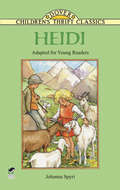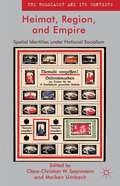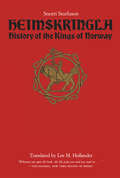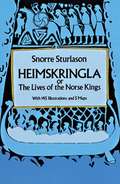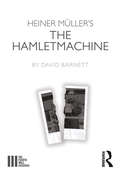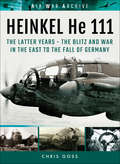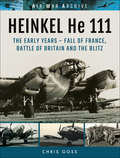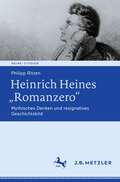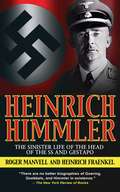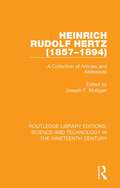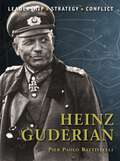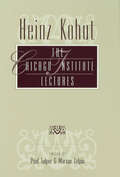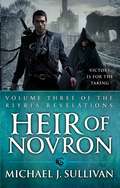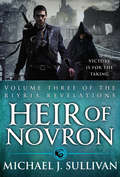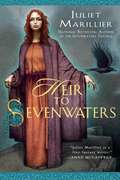- Table View
- List View
Heidi: Adapted for Young Readers (Dover Children's Thrift Classics)
by Johanna Spyri Thea KlirosBeloved classic about the effervescent, nature-loving Swiss miss who ultimately transforms the lives of many people -- among them Clara, a handicapped young lady from a wealthy German family; Peter, a goatherd, and his blind grandmother; and above all, Heidi's embittered, reclusive grandfather.
Heimat, Region, and Empire
by Claus-Christianw. Szejnmann Maiken UmbachThis collection brings together international scholars pursuing cutting-edge research on spatial identities under National Socialism. They demonstrate that the spatial identities of the Third Reich can be approached as a history of interrelated dimensions; Heimat, region and Empire were constantly reconstructed through this interrelationship.
Heimskringla History of the Kings of Norway: History of the Kings of Norway
by Snorri SturlusonBeginning with the dim prehistory of the mythical gods and their descendants, Heimskringlarecounts the history of the kings of Norway through the reign of Olaf Haraldsson, who became Norway's patron saint. Once found in most homes and schools and still regarded as a national treasure,Heimskringla influenced the thinking and literary style of Scandinavia over several centuries.
Heimskringla the Olaf Sagas
by Snorre SturlasonImmerse yourself in the epic world of Norse history and mythology with Snorre Sturlason's "Heimskringla: The Olaf Sagas." This monumental work, written by one of medieval Iceland's most prominent historians, provides a detailed and captivating account of the lives and deeds of the legendary kings of Norway, with a particular focus on the sagas of Olaf Tryggvason and Saint Olaf Haraldsson."Heimskringla," often considered the pinnacle of Old Norse literature, opens a window into the Viking Age, a time of exploration, conquest, and the spread of Christianity in Scandinavia. Snorre Sturlason's masterful storytelling brings to life the heroic exploits, complex personalities, and dramatic events that shaped the course of Norwegian history.The Olaf Sagas, which form the core of this work, chronicle the reigns of two of Norway's most celebrated monarchs. Olaf Tryggvason, a fierce warrior and devout Christian, is portrayed in his efforts to consolidate Norway and spread the Christian faith. His saga is filled with thrilling battles, daring adventures, and spiritual struggles, offering readers a vivid portrayal of a king determined to unify his realm.Saint Olaf Haraldsson, known as Olaf the Holy, continues this narrative with his own remarkable story. His saga recounts his relentless campaigns to establish Christianity as the dominant religion in Norway, his conflicts with powerful chieftains, and his eventual martyrdom at the Battle of Stiklestad. Saint Olaf's legacy as a national hero and saint is explored with depth and reverence, highlighting his enduring influence on Norwegian culture and identity."Heimskringla: The Olaf Sagas" is an essential read for anyone interested in Norse history, Viking culture, and medieval literature. Snorre Sturlason's intricate prose and rich historical detail provide a comprehensive and engaging exploration of the Viking Age, making this work a timeless classic.Join Snorre Sturlason on a journey through the sagas of the Olaf kings, and discover the heroic tales and enduring legacies that have shaped the history and mythology of Scandinavia. "Heimskringla: The Olaf Sagas" offers a captivating blend of history, legend, and literary artistry that continues to inspire readers around the world.
Heimskringla: or, The Lives of the Norse Kings
by Snorri SturlusonGreat classic by Icelandic poet/chieftain chronicles the reigns of 16 high kings descended from the warrior-wizard god Odin. Major section on 15-year reign of Olav II Haraldson, patron saint of Norway. Based on earlier histories, oral traditions, plus new material by author, all presented with intelligence, warmth and objectivity. Over 130 illustrations and 5 maps.
Heiner Müller's The Hamletmachine (The Fourth Wall)
by David Barnett"I’m good Hamlet gi’me a cause for grief" At first glance, readers of The Hamletmachine (1979) could be forgiven for wondering whether it is actually a play at all: it opens with a montage of texts that are not ascribed to a character, there is no vestige of a plot, and the whole piece lasts a total of ten pages. Yet, Heiner Müller’s play regularly features in theatres’ repertoires and is frequently staged by university theatre departments. In four short chapters, David Barnett unpicks the complexities of The Hamletmachine’s writing and frames its author as an experimental, politically committed writer who confronts the shortcomings of his age. In considering the problems Müller poses for the play’s performance, he also discusses two exemplary productions in order to show how the work can engage very different audiences. This book examines why such a compact, radically open, and yet seemingly obscure play has proved so popular.
Heinkel He 111: The Blitz and War in the East to the Fall of Germany (Air War Archive Ser.)
by Chris GossThe Heinkel He 111 was the main workhorse of the Luftwaffes bomber force throughout much of the Second World War. Consequently, when Hitler launched Operation Barbarossa in June 1941, three entire Kampfgeschwader consisted of He 111s. Initially used as direct support for the German ground forces, as the campaign progressed the He 111 was switched to attacking the Soviet infrastructure, particularly trains and marshaling yards, and used as a transport aircraft taking in supplies and for troop evacuation. Variants of the He 111 were used in anti-shipping roles, in both the Atlantic and the Mediterranean, and even for aerial launching of V-1 flying bombs, continuing the war against the towns and cities of the United Kingdom. In this selection of unrivaled images collected over many years, and now part of Frontline's new War in the Air series, the operations of this famous aircraft in the latter years of the Second World War are portrayed and brought to life. A companion title to Heinkel He 111: The Early Years.
Heinkel He 111: The Early Year—Fall of France, Battle of Britain and the Blitz (Air War Archive)
by Chris GossConsidered to be the best known German bomber of the Second Wold War, the Heinkel He 111 served in every military front in the European theatre, having first being deployed in the Spanish Civil War in 1936. It then saw extensive service in the invasion of Poland, the Norweigan campaign and the invasion of the Low Countries and France in 1940. When the Luftwaffe was tasked with destroying Britain&’s ability to resist invasion in 1940, the He 111 formed almost half of the Gruppen employed by Luftflotte 2 and Luftflotte 3. When the Luftwaffe switched to attacking cities and industrial sites the Heinkel 111 was widely employed, with raids against targets such as London, Coventry, Bristol, Birmingham and Liverpool. In this selection of unrivalled images collected over many years, the operations of this famous aircraft in the early years of the war – particularly the invasion of Poland, the Blitzkrieg in the West, the Battle of Britain and the very early stages of the Blitz – are portrayed and brought to life.
Heinrich Heines „Romanzero“: Mythisches Denken und resignatives Geschichtsbild (Heine-Studien)
by Philipp RitzenDie Untersuchung des letzten großen Gedichtzyklus von Heinrich Heine, des „Romanzero“, legt mythische Denkstrukturen frei, die nach einschlägigen Mythostheorien (Blumenberg, Eliade) eine ordnende Funktion in einer dem Menschen als Chaos erscheinenden Welt erhalten. Zugleich ist mythisches Denken zyklisch. Heine gestaltet im „Romanzero“ historische Situationen aus allen Epochen und zeichnet drastisch die Perpetuierung von Herrschaft und Ungleichheit nach. Der Mythos vermag keine Hoffnung zu kreieren. Heine entwirft am Ende seines Lebens in seiner „Matratzengruft“ ein resignatives Bild von Menschheit und Geschichte.
Heinrich Heshusius and Confessional Polemic in Early Lutheran Orthodoxy (St Andrews Studies In Reformation History Ser.)
by Michael J. HalvorsonHeinrich Heshusius (1556-97) became a leading church superintendent and polemicist during the early age of Lutheran orthodoxy, and played a major role in the reform and administration of several German cities during the late Reformation. As well as offering an introduction to Heshusius's writings and ideas, this volume explores the wider world of late-sixteenth-century German Lutheranism in which he lived and worked. In particular, it looks at the important but inadequately understood network of Lutheran clergymen in North Germany centred around universities such as Rostock, Jena, Königsberg, and Helmstedt, and territories such as Braunschweig-Wolfenbüttel, in the years after the promulgation of the Formula of Concord (1577). In 1579, Heshusius followed his father Tilemann to the newly founded University of Helmstedt, where Heinrich served as a professor on the philosophy faculty and established lasting connections within the Gnesio-Lutheran party. In the 1590s, Heshusius completed his doctoral degree in theology and worked as a pastor and superintendent in Tonna and Hildesheim, publishing over seventy sermons as well as a popular catechism based on the Psalms and Luther's Small Catechism. As confessional tensions mounted in Hildesheim, Heshusius worked as a polemicist for the Lutheran cause, pressing for the conversion or expulsion of local Jews. At the same time, Heshusius began to argue aggressively for the expulsion of Jesuits, who had been increasing in number due to the activities of the local bishop and administrator, Ernst II of Bavaria. By discussing the connection between these two expulsion efforts, and the practical activities Heshusius undertook as a preacher, catechist, and administrator, this study portrays Heshusius as a zealous protector of Lutheran traditions in the face of confessional rivals. Understanding this zeal, and the policies, piety, and propaganda that came as a result, is an important factor in relating how Lutheran orthodoxy gained momentum within Germany in the last decades of the sixteenth century. In all this book will reveal the complex characteristics of an important (but virtually unknown) Lutheran superintendent and theologian active during the era of confessionalization, providing a useful resource for the ongoing efforts of scholars hoping to understand the nature of orthodoxy and its importance for early modern Europeans.f
Heinrich Himmler
by Peter LongerichAs head of the SS, chief of police, 'Reichskommissar for the Consolidation of Germanness', and Reich Interior Minister, Heinrich Himmler enjoyed a position of almost unparalleled power and responsibility in Nazi Germany. Perhaps more than any other single Nazi leader aside from Hitler, his name has become a byword for the terror, persecution, and destruction that characterized the Third Reich. His wide-ranging powers meant that he bore equal responsibility for the repression of the German people on the home front and the atrocities perpetrated by the SS in the East. Yet, in spite of his central role in the crimes of the Nazi regime, until now Himmler has remained a colourless and elusive figure in the history of the period. <p><p> In this, the first-ever comprehensive biography of the SS-Reichsführer, leading German historian Peter Longerich puts every aspect of Himmler's life under the microscope. Masterfully interweaving the story of Himmler's personal life and political career with the wider history of the Nazi dictatorship, Longerich shows how skilfully he exploited and manipulated his disparate roles in the pursuit of his far-reaching and grandiose objectives. In the process, he illuminates the extraordinary degree to which Himmler's own personal prejudices, idiosyncrasies, and predilections made their mark on the organizations for which he was responsible - especially the SS, which in so many ways bore the characteristic hallmarks of its leader, and whose history remains both incomplete and incomprehensible without a detailed and intimate knowledge of its deeply sinister commander-in-chief.
Heinrich Himmler: A Detailed History of His Offices, Commands, and Organizations in Nazi Germany
by Rolf MichaelisAll of Heinrich Himmler&’s roles and official positions are described in detail
Heinrich Himmler: The Sinister Life of the Head of the SS and Gestapo
by Heinrich Fraenkel Roger ManvellAuthors Roger Manvell and Heinrich Fraenkel, notable biographers of the World War II German leaders Joseph Goebbels and Herman Goring, delve into the life of one of the most sinister, clever, and successful of all the Nazi leaders: Heinrich Himmler. As the head of the feared SS, Himler supervised the extermination of millions. Here is the story of how a seemingly ordinary boy grew into an obsessive and superstitious man who ventured into herbalism, astrology, and homeopathic medicine before finally turning to the "science" of racial purity and the belief in the superiority of the Aryan people.
Heinrich Kaan’s “Psychopathia Sexualis”: A Classic Text in the History of Sexuality
by Melissa Haynes Benjamin A. Haynes Heinrich Kaan"With Heinrich Kaan's book we have then what could be called the date of birth, or in any case the date of the emergence, of sexuality and sexual aberrations in the psychiatric field." Michel Foucault, Abnormal: Lectures at the Collège de France, 1974-1975Heinrich Kaan's fascinating work--part medical treatise, part sexual taxonomy, part activist statement, and part anti-onanist tract--takes us back to the origins of sexology. He links the sexual instinct to the imagination for the first time, creating what Foucault called "a unified field of sexual abnormality." Kaan's taxonomy consists of six sexual aberrations: masturbation, pederasty, lesbian love, necrophilia, bestiality, and the violation of statues. Kaan not only inaugurated the field of sexology, but played a significant role in the regimes of knowledge production and discipline about psychiatric and sexual subjects. As Benjamin Kahan argues in his Introduction, Kaan's text crucially enables us to see how homosexuality replaced masturbation as the central concern of Euro-American sexual regulation. Kaan's work (translated into English for the first time here) opens a new window onto the history of sexuality and the history of sexology and reconfigures our understanding of Richard von Krafft-Ebing's book of the same name, published some forty years later.
Heinrich Rudolf Hertz: A Collection of Articles and Addresses (Routledge Library Editions: Science and Technology in the Nineteenth Century #6)
by Joseph F. MulliganThis book, first available in 1994, was published to commemorate the one-hundredth anniversary of Heinrich Hertz’s death at the terribly young age of thirty-six. The introductory biography together with eleven papers by Hertz and seven about him are intended to highlight the importance of Hertz’s contributions to physics and at the same time to serve the needs of anyone interested in doing research on this highly gifted scientist.
Heinrich Rudolf Hertz: A Collection of Articles and Addresses (Routledge Revivals #6)
by Joseph F. MulliganPublished in 1994: This book is to commemorate the one hundredth anniversary of Heinrich Hertz’s death at the terribly young age of thirty-six. The introductory biography together with eleven papers by Hertz and seven about him are intended to highlight the importance of Hertz’s contributions to physics and at the same time to serve the needs of anyone interested in doing research on this highly gifted scientist.
Heinrich Schenker and Beethoven's 'Hammerklavier' Sonata (Royal Musical Association Monographs #23)
by Nicholas MarstonIn 1912 Heinrich Schenker contracted with the Viennese publisher Universal Edition to provide an 'elucidatory edition' (Erl erungsausgabe) of Beethoven's last five piano sonatas. Each publication would comprise a score, newly edited by Schenker and using the composer's autograph manuscript as principal source, together with a substantial commentary combining analytical, text-critical and performance-related matter. Four of the five editions appeared between 1913 and 1921, but that of the 'Hammerklavier' Sonata, op. 106, was never published. It has generally been assumed that this was simply because Schenker was unable to locate the autograph manuscript, which remains missing to this day. But as Nicholas Marston shows in a detailed history of the Erl erungsausgabe project, other factors were involved also, including financial considerations, Schenker's health concerns, and his broader theoretical ambitions. Moreover, despite the missing autograph he nevertheless developed a voice-leading analysis of the complete sonata during the years 1924-1926, a crucial period in the development of his mature theory of tonal music. Marston's book provides the first in-depth study of this rich analysis, which is reproduced in full in high-quality digital images. The book draws on hundreds of letters and documents from Schenker's Nachla it both adds to our biographical knowledge of Schenker and illuminates for the first time the response of this giant of music theory to one of the most significant masterworks in all music.
Heinz Guderian
by Adam Hook Pier BattistelliThis book gives a focused, military biography of Heinz Guderian, perhaps the most highly respected German tank commander of World War II. Guderian was a typical product of the Prussian military elite; the son of a general in the army, there was little doubt that he would follow in his father's footsteps. Some consider Guderian to be the founding father of blitzkrieg warfare, and he certainly brought the whole concept to public attention and prominence, chiefly through the publication of his book Achtung Panzer in 1937. He commanded the XIX Motorized) Army Corps in the 1939 Polish campaign, and Panzergruppe Guderian during Operation Barbarossa. In March 1943 he became chief inspector of the Panzer forces, but even the great tank commander could achieve little more than to delay the inevitable defeat of Germany.
Heinz Kohut: The Chicago Institute Lectures
by Paul Tolpin Marian TolpinDelivered to advanced candidates at The Chicago Institute for Psychoanalysis in 1974-75, The Chicago Institute Lectures reveal a Kohut in transition, a Kohut wrestling with the creative tension in psychoanalysis between tradition and innovation, between continuity and change, even as he worked toward the psychology of the self "in the broad sense" that marked his decisive break from traditional psychoanalytic thought. Lightly edited by the Tolpins to preserve their authenticy, these lectures preserve the voice, the intellectual style, and the pedagogical bearing of a gifted creator in the very midst of creation.We find here a casual Kohut, thinking through in a relaxed and conversational way the assumptions that would become foundational to mature self psychology. The developmental trajectory of self-selfobject relationships, the role of selfobject failures in different types of psychopathology, the complex relationship between givens and the psychological environment in pathogenesis, the role of conflict in normal development and in psychopathology--these are among the recurrent themes taken up in these lectures. And there are, as well, Kohut's provocative asides on the child-rearing practices of his day, including the contrast between over- and understimulation, the impact of healthy parental sexuality on child development, and the difference between the normal oedipal phase of the self and the Oedipus complex. The clinical viewpoint of mature self psychology is anticipated in many ways, perhaps no more clearly than in Kohut's powerful reassessment of the perversions.The Chicago Institute Lectures are more than a key historical document in the evolution of psychoanalytic self psychology; they preserve the voice, the intellectual style, and the pedagogical bearing of a gifted creator in the very midst of creation.
Heir Of Novron: The Riyria Revelations (Riyria Revelations)
by Michael J SullivanVICTORY IS FOR THE TAKINGThe New Empire intends to celebrate its victory over the Nationalists with a day that will never be forgotten. On the high holiday of Wintertide, the empress will be married, and Degan Gaunt and the Witch of Melengar will be publically executed. Once the empress suffers a fatal accident, everything will be perfect. There is only one problem - Royce and Hadrian have finally found the Heir of Novron.'This epic fantasy showcases the arrival of a master storyteller' Library Journal on Theft of SwordsThe Riyria RevelationsTHEFT OF SWORDSRISE OF EMPIREHEIR OF NOVRONThe Riyria ChroniclesTHE CROWN TOWER THE ROSE AND THE THORN
Heir of Novron: Theft Of Swords, Rise Of Empire, Heir Of Novron (The Riyria Revelations #3)
by Michael J. SullivanThe New Empire intends to mark its victory over the Nationalists with a bloody celebration. On the high holiday of Wintertide, the Witch of Melengar will be burned and the Heir of Novron executed. On that same day the Empress faces a forced marriage, with a fatal accident soon follow. The New Empire is confident in the totality of its triumph but there's just one problem-Royce and Hadrian have finally found the true Heir of Novron---and they have their own holiday plans.When author Michael J. Sullivan self-published the first books of his Riyria Revelations series online, they rapidly became ebook bestsellers. Now, Orbit is pleased to present the complete series for the first time in bookstores everywhere. Heir of Novron is the final volume of The Riyria Revelations and includes Wintertide and ---available for the first time--- the final volume, Percepliquis. BOOKS IN THE RIYRIA REVELATIONSTheft of Swords (The Crown Conspiracy & Avempartha)Rise of Empire (Nyphron Rising & The Emerald Storm)Heir of Novron (Wintertide & Percepliquis)
Heir to Sevenwaters (Sevenwaters #4)
by Juliet MarillierThe chieftains of Sevenwaters have long been custodians of a vast forest, said by some to be one of the last refuges of the Tuatha De Danann, the Fair Folk of ancient story. Whatever the truth, Human and Otherworld dwellers have existed side by side in peace, sharing a wary trust... until the spring when Lady Aisling of Sevenwaters finds herself expecting another child, and everything changes. With her mother pregnant, Clodagh fears for her health, as Aisling is well past the safe age for childbearing. Her father, Lord Sean of Sevenwaters, son of the famous Sorcha who performed her miraculous sacrifice all those years ago, faces his own difficulties, as warring factions threaten his borders. When Aisling gives birth, the responsibility of caring for the infant falls to Clodagh while her mother recovers. Then the family's joy turns to despair when an unspeakable horror falls upon Sevenwaters. Clodagh must finally confront the shadowy mystery of the silent forest and descend to the Otherworld, to find out why the trust between the two realms has been broken so tragically. Accompanied on her quest by a warrior of uncertain allegiance, Clodagh will have her courage tested to breaking point. The reward may be far greater than she ever dreamed...
Heir to the Duke: Regency Wallflower Finds Her Bloom and Catches the Eye of a Brooding Duke (The Duke's Sons #1)
by Jane AshfordA dazzling Regency romance from bestselling author Jane Ashford. Life is predictable for a Duke's first son. Or so he once thought…He was delighted that she shared this pleasure with him. And how lovely she looked, out here on the water. The wind had whipped color into her cheeks. Her sandy hair leaped and curled around her face. And her gray eyes shimmered and sparkled. Violet's beauty—for it was undoubtedly beauty—arose from animation, he realized. When she was subdued and distant, as she'd always been when he saw her before their marriage, it was hidden. A secret, like the flower she was named for, obscured by broader leaves in the forest. But now he'd discovered a different Violet—vibrant, responsive. Watching her laugh as spray spattered her sleeve, he felt extremely fortunate. His instincts had somehow led him to a prize.As eldest son of the Duke of Langford, Nathaniel Gresham sees his arranged marriage to Lady Violet Devere as just another obligation to fulfill?highly suitable, if unexciting. But as Violet sets out to transform herself from dowdy wallflower to dazzling young duchess-to-be, proper Nathaniel sets out to prove he's a match for his new bride's vivacity and daring.Oppressed by her family all her life—especially her domineering and horrible grandmother—Lady Violet can't wait to enjoy the freedom of being a married woman. But then Violet learns her family's sordid secret, and she's faced with an impossible choice?does she tell Nathaniel and risk losing him, or does she hide it and live a lie?
Heir to the Empire City: New York and the Making of Theodore Roosevelt
by Edward P. KohnTheodore Roosevelt is best remembered as AmericaOCOs prototypical ocowboyOCO presidentua Rough Rider who derived his political wisdom from a youth spent in the untamed American West. But while the great outdoors certainly shaped RooseveltOCOs identity, historian Edward P. Kohn argues that it was his hometown of New York that made him the progressive president we celebrate today. During his early political career, Roosevelt took on local Republican factions and Tammany Hall Democrats alike, proving his commitment to reform at all costs. He combated the cityOCOs rampant corruption, and helped to guide New York through the perils of rabid urbanization and the challenges of accommodating an influx of immigrantsuexperiences that would serve him well as president of the United States. A riveting account of a man and a city on the brink of greatness, "Heir to the Empire City" reveals that RooseveltOCOs true education took place not in the West but on the mean streets of nineteenth-century New York.
